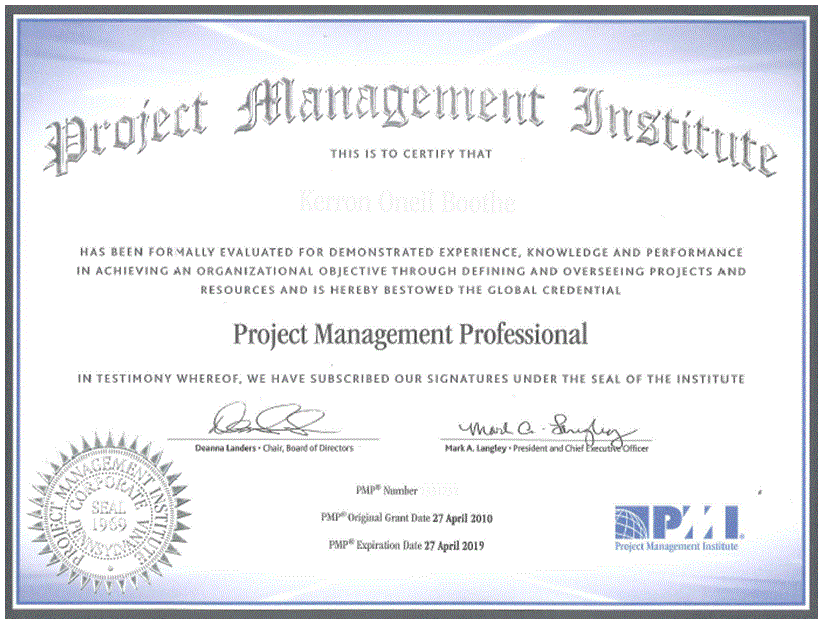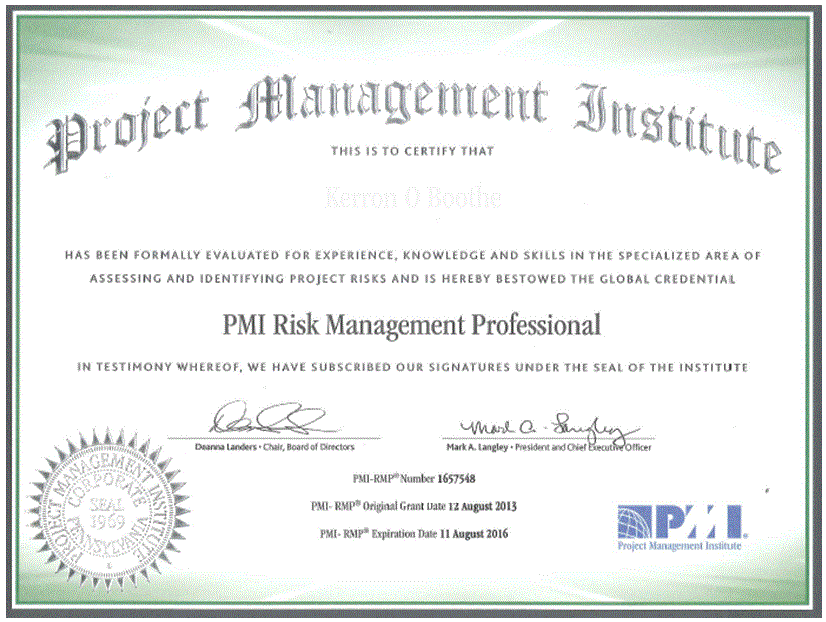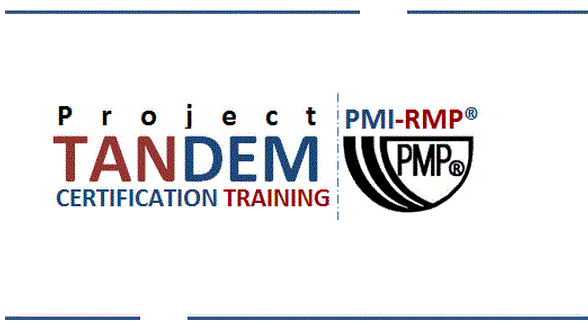PROJECT TANDEM training
Project Management Professional (PMP)
View the official PMP Handbook from www.pmi.org
-
Integration Management
-
Scope Management
-
Time Management
-
Cost Management
-
Quality Management
-
Human Resource Management
-
Risk Management
-
Communications Management
-
Procurement Management
-
Professional Responsibility,
-
Project Management Context, Framework, Processes, and
-
PMP® Examination tips, tricks, and strategy.
Standard Syllabus content for Project management training

Standard content for Risk Management Professional (PMI-RMP) training
View the official PMI-RMP Exam Content Outline at www.pmi.org
Overal Objectives:
-
Describe and understand all Risk Management defined processes, as outlined in the current edition of the PMI® PMBOK® Guide
-
Gain the necessary information to prepare for the PMI® Project Risk Management Professional (PMI-RMP) Certification Exam
-
Use internationally-recognized best practices for managing project and operations risks.
-
Become PMI-RMP exam level profisscient various techniques in risk analyis
-
Apply risk management techniques to determine the true cost and schedule for projects and operations
-
Demonstrate the impact of successful Risk Management to the organization
-
Avoid common risk management pitfalls
-
Describe Risk Management principles and techniques and how they apply to the day-to-day management of projects and operations
-
Have a practical set of self-study techniques and bibliography of reference material
-
Use common risk management terminology
-
Be more focused and proactive about preventing problems, rather than just dealing with them as they occu
Overview of the PMI-RMP Exam
-
Requirements
-
Domain Areas
-
Risk Management Overview
-
Definition of risks
-
Risk Breakdown structure (RBS)
-
Risk Categories
-
What do you need before you can effectively start risk management?
-
How does risk management fit into the project management process and operations?
-
What risk management is and why can it make or break your career
-
Project risks and operation risks?
-
Negative risks and positive risks (Opportunities)
-
Plan Risk Management
-
Identify Risks
-
Perform Qualitative Risk Analysis
-
Perform Quantitative Risk Analysis
-
Plan Risk Responses
-
Monitor and Control Risks
-
Creating a Risk Management Plan (RMP)
-
Analyzing contents of a model RMP
-
Applying a standard template to create your RMP
-
Identifying project risk
-
Common sources of project risk
-
Creating Ishikawa diagrams to analyze cause and effect relationship
-
Checklists
-
Developing a Risk Register
-
Analyzing contents of a model Risk Register
-
Applying a proven template to create your Risk Register
-
Documenting risks for future assessments
-
Analyzing risks through qualitative measures
-
Performing probability and impact analyses of identified
-
Applying the probability and impact matrix
-
Advanced applications of qualitative analysis
-
Prioritizing analysis results
-
Ranking project risks
-
Differentiating between acceptable and unacceptable risks
-
Quantifying effects of risk events on the project
-
Determining probability of achieving cost and time objectives
-
Calculating contingency reserves
-
Identifying trends in quantitative analysis
-
Ranking risks by actuarial cost
-
Tools for analysis
-
Expected Monetary Value (EMW)
-
Three-point estimates
-
Probability distributions
-
Delphi Technique
-
Simulation
-
Implementing risk response strategies
-
Threats: Accept, Avoid, Transfer and Mitigate
-
Opportunities: Exploit, Share, Enhance
-
Quantifying residual risks and secondary responses
-
Creating contigency plans
-
Determining the worst case scenario
-
Recalculating confidence levels
-
Finalizing risk budget
-
Identifying emerging project risks
-
Matching identified project risk with controls including Risk Audit, Variance Reports, Reserve Analysis
-
Anticipating risk events through risk triggers
-
Measuring risk using earned value analysis (EVA)
-
Ensuring effective change control
-
Developing a reliable change request process
-
What You Need Before You Can Do Risk Management
-
The Risk Management Processes
-
Plan Risk Management Process
-
The Identify Risks Process
-
The Perform Qualitative Risk Analysis Process
-
The Perform Quantitative Risk Analysis Process
-
The Plan Risk Responses Process
-
The Monitor And Control Risks Process

Content for Agile Project Management training
View the official PMI-ACP Exam Content Outline at www.pmi.org
The Course Objectives
-
Prepare the participants for the PMI-ACP Certification.
-
To impart sufficient knowledge and skills to the participants so that they can start practising the agile project management methodology at their work place.
-
Provide 30 contact hours of instructor led training credits to the participants
The course outline
1. Overview of Agile Project Management
-
Agile manifesto
-
Popular agile methodologies
-
Agile principles and practices
-
Quick overview of the agile practices using scrum
2. Understanding the key roles and artefacts of scrum
-
Scrum master (Agile project manager)
-
Product owner
-
Team members
-
Product backlog
-
Sprint planning meeting
-
Sprint backlog
-
Tracking board
-
Sprint demo
-
Retrospectives
3. Understanding user stories
-
The anatomy of a user story
-
User story development techniques
-
Story points
-
Ideal time
-
Wide band delphi
-
Playing poker
4. The sprint planning meeting
-
The sprint planning meeting time box
-
Feature prioritization
-
The tracking board
-
Definition of done
-
Load balancing
5. Sprinting
-
Self organized teams
-
Work volunteering
-
Daily stand up meetings
-
Burn down chart updation
-
Sprint demo meetings Continuous improvement process
-
Velocity
-
Sprint retrospectives
-
Scaling scrum
-
Co-located and distributed teams
6. Best practices and concepts
-
Agile tooling
-
Osmotic communications for co-located and distributed teams
-
WIP limits
-
Cumulative flow diagram
-
Process tailoring
-
Affinity estimating
-
Product road map
-
Story maps
-
Wire frames
-
Chartering
-
Frequent verification and validation
-
Test driven development / test first development
-
Continuous integration
-
Project charter for an agile project
-
Participatory decision models
-
Process analysis techniques
-
Self assessment
-
Value based assessment
7. Soft skills
-
Negotiation
-
Emotional intelligence
-
Collaboration
-
Adaptive leadership
-
Conflict resolution
-
Servant leadership
-
Building high performance teams
8. Value based prioritization
-
Return on investment (ROI)
-
Net present value (NPV)
-
Internal rate of return (IRR)
-
Compliance
-
Customer valued prioritization
-
Minimally marketable feature (MMF)
-
Relative prioritization / ranking
-
Business case development
9. Agile implementation
-
Agile contracting methods
-
Agile project accounting principles
-
Applying new agile practices
-
Compliance (Organization)
-
Control limits for agile projects
-
Failure modes and alternatives
-
Globalization, Culture and team diversity
-
Innovation games
-
Principles of systems thinking (complex, adaptive, chaoes)
-
Regulatory compliance
-
Variance and trend analysis
-
Vendor management

What you get
You will get to follow all the proven methods and techniques required to make you PMI certified in the respective areas.
-
PMP®/PMI-RMP®/ PMI-ACP® certification prep guide
-
1000+ PMI® - style prep questions
-
Pens, Pencils, Markers, Eraser
-
Writing material
-
Lunch, drinks and snacks as per time of day
-
Project Tandem Course Completion Certification
-
30 contact hour PDUS required for re-certification
Learning Strategies for all certification courses
-
Multiple learning styles
-
Repetition through various instructional methods
-
Using different ways of assimilating same knowledge
-
Mnemonics, Study aids for instant recall
-
Multiple In-classroom practice tests and final Exam
-
Presentation of key information to memorize
-
Developing test taking strategies
